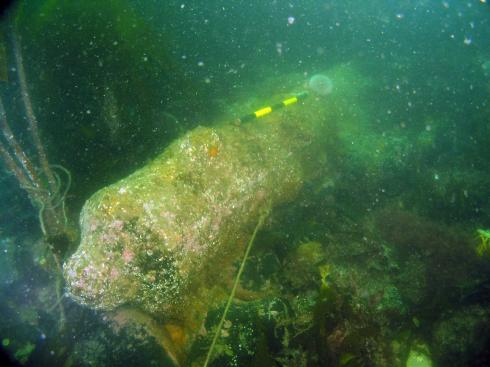In 1999 Phil Richards was diving near Mingary Castle off Ardnamurchan at the Northern end of the Sound of Mull. Through thick kelp he spotted four guns lying end to end and a number of small artefacts lying scattered on the seabed.

Among other finds he found a fifth gun lying to the north west of the other guns, a stoneware Bellarmine jug, a copper kettle and a possible lead vent apron with what appeared to be the date 1638 inscribed on it. Unfortunately, once it was discovered, there was an immediate threat to the site from possible looting.
As the evidence seemed to point to a 17th century wreck, of possible historical, archaeological or artistical importance. As a result any artefacts still undiscovered at the site could prove invaluable to identifying the site. As a result the Mingary Castle site was designated under the Protection of Wrecks Act (1973) in 2000.
The site was featured in the Channel Four series 'Wreck detectives'. Research carried out for the programme suggested that the site is the remains of a Dutch ship that was lost near the Castle in 1644, based on an account of the event written in the diary of John Weir, a puritan who was being held in the castle at the time.
Wessex Archaeology's Investigations
Historic Scotland requested Wessex Archaeology visit the site to record and position any exposed remains using simple tracked diver and metal detector surveys. We were also asked to find the full extent of the site and to carry out a topographic survey. To inform the ongoing management of the site, we offered an assessment as to whether a Visitor Scheme would be appropriate and whether a nearby fish farm was having any visible effect on the site environment.
Results
Wessex Archaeology divers noted a number of small finds from the area such as pieces of lead sheeting and brick which strengthen the hypothesis that this is a ship wreck site, rather than an area where a ship may have jettisoned its guns.
The local igneous rock produced several of natural metal detector hits, making it difficult to locate metal artefacts using this method. However, the distinct seabed types identified and the plant life resident on this site are indicative of a relatively dynamic seabed environment and few artefacts remain which are visible on the seabed surface. However, some wood has been found beneath the guns or within pockets of sediment and other artefacts may remain buried in places.
You can download the full report of Wessex Archaeology's investigations as a PDF: Mingary Castle, Designated Site Assessment, Full Report
Map showing the location of the protected wreck at Mingary Castle
[gmap markers=big red::56.69,-6.07339|zoom=8 |center=56.69,-6.07339 |width=100% |height=500px |control=Small |type=Map]